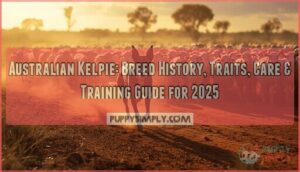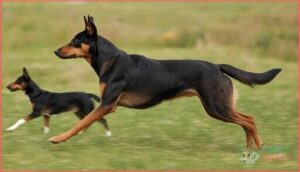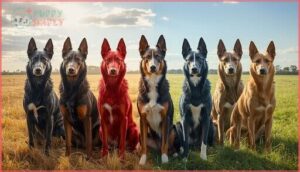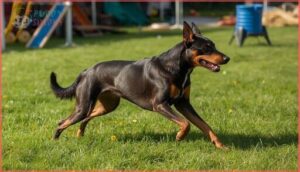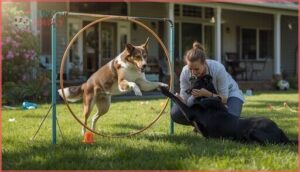This site is supported by our readers. We may earn a commission, at no cost to you, if you purchase through links.
The Australian Kelpie can herd 500 sheep across miles of unforgiving terrain with minimal direction, a feat that places this breed among the world’s most capable working dogs. Born from the union of Scottish herding lines and Australia’s demanding outback conditions, the Kelpie developed an independence and stamina that few breeds can match.
These dogs don’t just follow commands; they anticipate needs, solve problems on the fly, and work tirelessly in temperatures that would sideline other breeds.
Whether you’re considering a Kelpie as a farm partner or family companion, understanding their powerful herding drive, superior intelligence, and intense exercise requirements will determine whether this outstanding breed fits your lifestyle.
Table Of Contents
- Key Takeaways
- Australian Kelpie Origins and History
- Physical Characteristics of The Kelpie
- Temperament and Behavior Traits
- Care, Grooming, and Exercise Needs
- Health Considerations and Training Tips
- Frequently Asked Questions (FAQs)
- What colors do Australian Kelpies come in?
- How big do Australian Kelpies get?
- Are Australian Kelpies good with cats?
- How long do Australian Kelpies usually live?
- Are Australian Kelpies easy to potty train?
- Are Australian Kelpies good apartment dogs?
- Can Kelpies be left alone during work hours?
- Do Australian Kelpies get along with cats?
- What jobs or activities suit Kelpies best?
- How much does an Australian Kelpie puppy cost?
- Conclusion
Key Takeaways
- Australian Kelpies are highly intelligent and independent, needing at least two hours of vigorous daily exercise to prevent boredom and destructive behavior.
- This breed’s herding instincts are strong, with over 95% showing natural herding behaviors that require structured outlets and early socialization.
- Kelpies are hardy and adaptable, but genetic health issues like hip dysplasia and progressive retinal atrophy mean regular vet checks and preventative care are essential.
- Their double coat sheds seasonally and needs weekly brushing, while their diet and grooming routines should match their active lifestyle for optimal health.
Australian Kelpie Origins and History
If you’re curious about where the Australian Kelpie comes from, you’re in the right spot. This breed’s story is shaped by its roots and the land it calls home.
Let’s look at the key moments that shaped the Kelpie’s history.
Scottish and British Herding Dog Ancestry
From Celtic dog origins to the Rutherford Collie influence, the Australian Kelpie’s ancestry reads like a lesson in animal genetics. You’ll find three key threads:
- Scottish Collies shaped breed characteristics.
- Dingo crossbreeding boosted endurance.
- Functional trait inheritance cemented herding dog legacy and significance.
They’re known for their natural herding instincts. This blend makes the Kelpie a standout in dog breeding and genetics.
Development in Australia’s Harsh Conditions
Building on their herding dog roots, Australian Kelpies were shaped by the raw demands of the outback. Extreme heat, drought, and rough terrain became their proving ground.
Their climate adaptation, terrain mobility, and drought resilience set new standards in animal husbandry and management. As working dogs, their disease resistance and livestock contribution quickly made them indispensable across Australia’s toughest stations.
Owners should be aware of progressive retinal atrophy, a condition that can affect the breed.
Breed Recognition and Name Origins
The breed earned official recognition in 1902 through the New South Wales Kennel Club, with standards formalized by 1905. The Kelpie name meaning traces back to a Scottish water spirit, chosen after J.D. Gleeson’s foundation female.
Early Kelpie shows, including the Royal Melbourne Show, showcased their breed characteristics and traits.
Today, the Working Kelpie registry maintains strict breeding standards, preserving authentic working bloodlines while breed standard evolution continues shaping both show and working lines.
Physical Characteristics of The Kelpie
The Australian Kelpie’s physical traits reflect generations of selective breeding for tough, demanding work. From their compact, athletic build to their weather-resistant coat, every feature has a purpose.
Here’s what you need to know about the Kelpie’s appearance, structure, and expected lifespan.
Size, Weight, and Body Structure
Ever noticed how the Australian Kelpie’s ideal proportions give it a muscular build and agility that’s hard to match? Males stand about 46–51 cm, females 39–46 cm, with weight following suit.
Size variability reflects both working and show lines, yet the breed standard always favors balanced strength and flexibility.
Growth stages are steady, shaping a classic Kelpie breed.
Coat Types and Color Variations
How does a Kelpie’s coat handle the wild swings of Australian weather? That double coat—short, dense, and rain-resistant—shows off functional adaptation.
Coat genetics drive color rarity, with black most common, while smoke blue and fawn are rare. Breed standards guide accepted shades, so your grooming needs change slightly with each color and texture.
- Double coat for weather protection
- Seven standard color variations
- Seasonal shedding impacts Dog Grooming
Lifespan and Breed Standard Features
Endurance is the Kelpie’s calling card, with Lifespan and Breed Standard Features shaped by Genetic Predispositions and Longevity Factors. Size Variations, Breed Conformation, and Color Genetics all play a role. You’ll find the Australian Kelpie’s Breed Characteristics and Traits reflected in their sturdy Dog Health and athletic build.
| Height (in) | Weight (lb) | Lifespan (yrs) |
|---|---|---|
| 17–20 | 25–45 | 11–16 |
| 17–20 | 30–45 | 10–13 |
| 17–20 | 25–35 | 13–15 |
| 17–20 | 30–40 | 12–14 |
Temperament and Behavior Traits
If you’re curious about what makes the Australian Kelpie tick, you’re in the right spot. Their personality and behavior can surprise even experienced dog owners.
Let’s look at the key traits that shape how Kelpies interact with you and your family.
Intelligence and Trainability
Imagine a dog that reads your gestures like a book and solves problems faster than you can set them up. That’s the Australian Kelpie—an intelligent dog with sharp learning speed, impressive obedience performance, and independent thinking.
Their social cognition stands out, making dog training rewarding if you use clear cues and positive reinforcement. Quick learners thrive on variety and challenge.
Energy Levels and Herding Instinct
You need to understand that the Australian Kelpie’s energy levels place them among the most demanding herding dogs. Your dog requires 60 to 120 minutes of vigorous daily exercise—nearly double what most herding breeds need. Without adequate activity intensity, 58% develop destructive behaviors.
Australian Kelpies demand 60 to 120 minutes of vigorous daily exercise—without it, over half develop destructive behaviors
These working dogs possess an innate herding instinct, with over 95% displaying natural herding behaviors that demand structured outlets to prevent frustration.
Family Compatibility and Socialization
Your Kelpie’s loyalty levels run deep, but proper socialization within the critical 4-6 month window determines success as a family pet. Early dog training and behavior work prevents herding instincts from disrupting child interaction.
With training consistency and responsible pet ownership, these dogs adapt well to multi-pet homes. Understanding dog behavior through structured pet care ensures your Kelpie becomes a confident, well-adjusted companion for active families.
Care, Grooming, and Exercise Needs
The Australian Kelpie’s care needs reflect its working dog heritage, balancing low-maintenance grooming with high-intensity exercise demands. While their short coat won’t require hours of upkeep, their legendary stamina means you’ll need a solid plan for daily activity and proper nutrition.
Let’s break down what it takes to keep your Kelpie healthy, active, and thriving.
Coat Maintenance and Shedding
Your Australian Kelpie’s double coat demands regular attention, especially during seasonal shifts. These hardy dogs shed moderately year-round, but spring and autumn bring coat blow frequency peaks where up to 80% of annual hair loss occurs.
Here’s your grooming plan:
- Weekly brushing with a slicker or bristle brush maintains coat health between shedding seasons
- Increase to 2-3 sessions weekly during spring and fall coat blows to manage loose undercoat
- Bathe every 6-8 weeks using mild, dog-safe shampoo—bathing best practices protect natural oils
- Check ears, trim nails, and brush teeth during each session for complete care
This routine aids skin health maintenance, allergen reduction in your home, and early detection of parasites or injuries. The grooming tool impact matters: over-bathing risks dry skin by stripping essential oils, so resist the urge to bathe too frequently even when working dogs get dirty.
Exercise Requirements and Activity Ideas
Beyond coat care, your Kelpie’s mental and physical hunger runs deep. Adult Australian Kelpies need a minimum of 2 hours of vigorous daily exercise—running, agility courses, herding trials, or frisbee sessions that tap into their instincts. Split activities throughout the day to match their endurance.
Mental stimulation through puzzle toys and scent games prevents destructive behaviors.
For puppies and seniors, adjust intensity to protect developing or aging joints while maintaining engagement.
Diet, Nutrition, and Routine Care
Fueling your Kelpie properly matches their exercise demands. Adult dogs weighing 10-20 kg need 160-275 grams of quality dog food daily, split into two meals. Choose AAFCO-approved formulas with high-quality meat proteins—chicken, beef, or lamb. Avoid toxic foods like chocolate, onions, grapes, and xylitol.
Puppy nutritional needs differ; premium medium-breed formulas support growing joints.
Brush weekly, trim nails regularly, and schedule vet checks to maintain pet health and wellness.
Health Considerations and Training Tips
Keeping your Australian Kelpie healthy and well-trained starts with understanding what this breed needs most. While Kelpies are generally hardy dogs, they can face certain genetic conditions that require attention, and their sharp minds need the right training approach.
Let’s look at the key health issues to watch for and how to stay ahead with preventative care. Additionally, we’ll explore the most effective ways to train and socialize your Kelpie.
Common Genetic and Health Issues
While Australian Kelpies are generally healthy dogs, they can face several genetic health challenges. Hip dysplasia affects joint development, causing arthritis and mobility problems. Eye disorders like Progressive Retinal Atrophy and Collie Eye Anomaly lead to vision loss. Neurological issues, particularly Cerebellar Abiotrophy, cause coordination difficulties.
Genetic testing and health screening help identify carriers early, allowing you to make informed decisions about your Kelpie’s care and breeding considerations.
Preventative Veterinary Care
Proactive veterinary care keeps your Kelpie thriving beyond genetic screening. Start vaccination schedules at 6-8 weeks, with full immunity developing around 16 weeks.
Year-round parasite prevention protects against fleas, ticks, and heartworm. Dental hygiene matters—brush teeth weekly to prevent gum disease. Clean ears regularly and trim nails every 4-6 weeks.
Annual health check-ups catch issues early, while pet insurance helps manage unexpected veterinary care costs.
Effective Training Methods and Socialization
Positive reinforcement transforms your Kelpie’s natural intelligence into reliable obedience. Keep training sessions under 15 minutes to match their attention span, using treats and praise to reinforce good behavior.
- Start early socialization at 4-6 months, exposing your puppy to diverse people, animals, and environments
- Redirect herding instincts through fetch games and agility training rather than allowing nipping
- Address behavioral challenges like excessive barking with “quiet” commands and mental stimulation
- Use clicker training techniques to sharpen timing and encourage problem-solving
- Involve your entire family in training to maintain consistent leadership and clear boundaries
Frequently Asked Questions (FAQs)
What colors do Australian Kelpies come in?
The breed standard recognizes seven colors, with black and chocolate brown dominating. Red, fawn, smoke blue, and tan variations appear regularly, while cream and dilute shades remain rare in Kelpie populations.
How big do Australian Kelpies get?
You can expect a medium-sized dog that stands 16 to 20 inches tall at the shoulder, weighing between 25 and 45 pounds, with males usually larger than females at full maturity.
Are Australian Kelpies good with cats?
Picture a young dog meeting a calm cat for the first time—early introduction and supervised interactions make all the difference.
Australian Kelpies, with strong herding instincts and intelligent temperament factors, can achieve long-term coexistence with cats through careful canine behavior and training.
How long do Australian Kelpies usually live?
Australian Kelpies generally live 11 to 16 years, which is on par with similar breeds. Breed lifespan depends on genetic disorders, veterinary care, and lifestyle factors—consistent exercise and proactive pet health and wellness are key to canine health.
Are Australian Kelpies easy to potty train?
Potty training can be straightforward with clear routines and patience, but puppy control and behavioral traits like high energy pose training challenges.
Success factors include consistency, positive reinforcement, and understanding dog behavior, keeping dog training and pet care practical and engaging.
Are Australian Kelpies good apartment dogs?
Living in an apartment with this dog breed demands intense owner commitment. Without daily outlets for their herding instinct and substantial dog exercise and activity, behavioral problem signs emerge.
Space adaptation success is rare, even with excellent pet care and substantial dog exercise and activity.
Can Kelpies be left alone during work hours?
If you’re working long hours, leaving a Kelpie alone can spark separation anxiety and restless behavior.
Prioritize exercise importance, socialization needs, and training strategies. Structured routines and mental stimulation are essential for this working dog’s well-being.
Do Australian Kelpies get along with cats?
Kelpies can get along with cats when Early Socialization and Training Techniques are used. Gradual Exposure, impulse control, and understanding Breed Characteristics and Traits help make for peaceful Pet Care and Health. Their Prey Drive means supervision and Safe Zones matter.
What jobs or activities suit Kelpies best?
Did you know Australian Kelpie can cover over 20 miles a day on farms?
That’s why they excel in herding trials, agility sports, detection work, therapy roles, and search rescue—making them top contenders in the Herding Group.
How much does an Australian Kelpie puppy cost?
Expect to pay anywhere from $600 to $1,500 for a puppy, though Pedigree Influence and Breeder Reputation can push prices higher. Geographic Variance matters, and Adoption Costs are lower, but Lifetime Expenses for pet care and health add up.
Conclusion
Choosing an Australian Kelpie is like harnessing the wind—fast, clever, and always moving. Their sharp instincts and boundless energy demand a life with purpose, whether on a farm or in an active household.
If you’re ready to meet them halfway, a Kelpie won’t just follow; they’ll lead, challenge, and enrich your days. Understanding their needs is the first step toward a partnership built on respect and trust, where both you and your dog can truly thrive together.
- https://www.aniforte.de/en/blogs/dogs/breed-portrait-australian-kelpie
- https://vetslovepets.com.au/blogs/dog/australian-kelpie-breed-guide
- https://www.collieball.com/blog/understanding-the-australian-kelpie-dog-breed-traits-and-care-guide
- https://www.bcg.org.au/old-dog-new-tricks-new-look-climate-kelpie-website-unveiled-at-cotton-conference/
- https://www.ukcdogs.com/breed-standards/australian-kelpie

